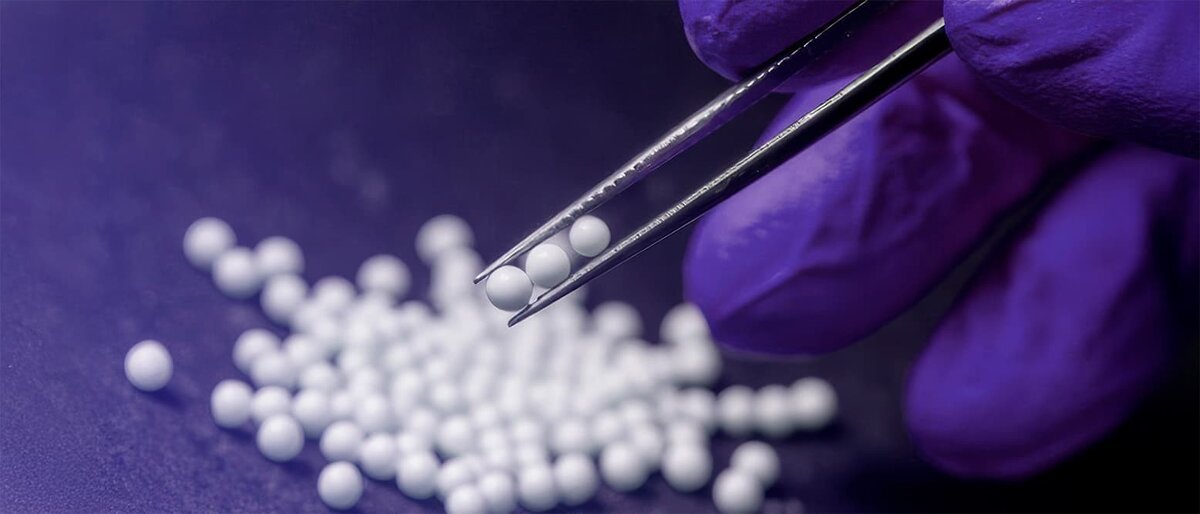Choosing the right size of lyophilized beads. What fits your application?
With a wide range of lyophilized beads to choose from, the correct size depends on your application, manufacturing scale, and budget.

Lyophilized beads are microspheres that contain freeze-dried reagents or active pharmaceutical ingredients (API). Lyophilized reagents can provide a number of advantages including protocol simplification, ambient shipping and storage, and extended shelf-life. Depending on the manufacturing process, lyophilized beads are characterized and controlled by parameters such as size, weight, morphology, moisture content, appearance, coloring, and excipient composition. Lyophilized bead manufacturers, including industry-leader Fortis, can tune these microspheres so that they are optimal for your application.
In general, smaller lyophilized beads (1.5 to 3.5 mm in diameter) will quickly dissolve. Their small size makes them ideal for microfluidic cartridges, however, this smaller size can also make them more difficult to handle individually and electrostatic charges on plastic walls can impact ease of use. Manufacturers like Fortis have specialized equipment and procedures to reduce electrostatic charges. Lyophilized beads of this size typically have minimal rehydration volume (usually between 10 µl and 50 µl) and may be appropriate for an individual reaction (e.g., qPCR).
Medium-sized beads of 3.5-5.0 mm in diameter accommodate more material. This can enable sustained or delayed release profiles (e.g., antibiotics) or be rehydrated as reagent pools (e.g., PCR mastermix). Beads in this size range can be handled easily with vacuum wands and are less susceptible to electrostatic tension. Depending on the lyophilized material, medium size beads can have good structural integrity and mechanical robustness to stresses encountered in handling, packaging, and transport. Typical rehydration volumes are 50 µl-100 µl.
The largest lyophilized beads are in the range of 10-20 mm in diameter, but these are uncommon. Most manufacturing processes for large beads involve injecting reagents into shaped molds and utilize a longer dehydration step. Because of the manufacturing challenges, these beads can be fragile, and they are also susceptible to core collapse. However, as they are easy to discern by eye, visual QC is a simple and quick process. As rehydration is performed with higher volumes of solution (usually aqueous, 1-2 ml), these beads are often used in enzymatic or colorimetric assays that require larger sample volumes. Typical applications include QC testing, food safety, and environmental assessments. Instead of large beads, manufacturers may suggest combining several smaller beads into a single reaction, as this is usually more cost-effective, easier to manufacture, and has higher yields.
As an alternative to large beads and for specific QC applications including food safety, respiratory, infectious disease testing, and environmental assessments, Fortis has developed lyophilized swabs. These swabs can accept a variety of reagents that are dispensed onto the swab prior to freeze drying (e.g., nucleic acid, virus, bacteria, and antigenic targets). The swab material must be non-reactive and be able to retain the reagent during the freeze-drying steps. To resuspend, the swab is immersed and rotated in a solution (commonly a standard assay or lysis buffer).
| Lyophilized Bead Size (Diameter) | Typical Use Case | Advantages | Disadvantages |
|---|---|---|---|
| Small: 1.5-3.5 mm | POC, molecular diagnostics, chips or cartridges | Rapid dissolving, small reaction volumes, robust to transport stress | Difficult to handle |
| Medium: 3.5-5.0 mm | Drug delivery, reagent pool, cosmetics | Protocol adherence, good transport stress tolerance | Potential waste if too much overage |
| Large: 10-20 mm | QC applications, food safety, environmental | Very easy to handle, QC by naked eye | Potential core collapse, fragile, expensive |
| Large Alternative: Lyophilized Swabs | QC applications, food safety, infectious disease testing, environmental | Ease of use, mechanical integrity, represents true sample delivery | Potential waste if overage |
Summary:
Choosing the correct lyophilized bead size is largely dependent on the application and required robustness for handling/shipping. While lyophilized bead manufacturers can often tune beads by excipients, the size needed will be directly related to the intended final concentration and resuspension volumes required. Depending on the yield required, combining several smaller beads or using lyophilized swabs can be more cost effective than utilizing larger beads.
Looking to get started on your lyophilization project? Fortis specializes in quick prototyping and scale-up of lyophilization beads. Contact Us.